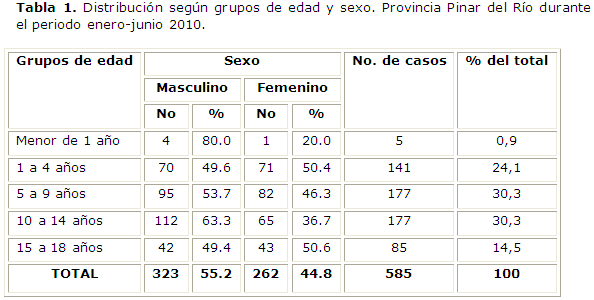Perinatal and Postnatal Factors Related with Bronchial Asthma in Pinar del Río Children
Keywords:
Asthma, Respiratory tract infections, Smoking.Abstract
Introduction: asthma is a disease that reminds physicians of the importance of clinical and epidemiological elements in the patient’s recognition. The disease appears by genetic and environmental factors.Objective: to describe the perinatal and postnatal factors for bronchial asthma in Pinar del Río pediatric patients.
Material and method: a descriptive study was conducted in Pinar del Rio Province during the period from January to June 2010. 585 asthmatic patients in pediatric ages were chosen, by stratified probability sampling, proportional to the patient population of the province’s towns. We considered each municipality as stratum. The systematic sampling technique was used. The absolute and relative frequencies of the studied qualitative variables were calculated.
Results: 10.8% of the mothers were smokers during pregnancy. 6.7% and 39.5% of the children were active and passive smokers, respectively. 34.2% of asthmatic children maintained exclusive breastfeeding up to three months. Rhinitis ranked first (55%) amongst allergic co-morbidities. 73.2% of the patients had colds, followed by tonsillitis and parasitic infections.
Conclusions: smoking (passive and active), living with pets, early and excessive consumption of cow's milk with the early retirement of exclusive breastfeeding, and respiratory infections, as part of the patient’s personal medical history, constitute altogether perinatal and postnatal factors related with the existence of asthmatic children in Pinar the Río, in which rhinitis and dermatitis were associated as part of the atopic natural history.
Downloads
References
1. GINA. Global Strategy for Asthma Management and Prevention. GINA Report, 2014; [aprox 2 pantallas]. Disponible en: http://www.ginasthma.org/local/uploads/files/GINA_Report_2014.pdf [citado 5 Oct 2011]
2. GINA. Global Strategy for the diagnosis and management of Asthma inchildren 5 years and younger. GINA Report, 2009;[aprox 2 pantallas]. Disponible en: http://www.ginasthma.org/local/uploads/files/GINA_Under5_2009_CorxAug11_1.pdf [citado 5 Oct 2011]
3. Cuba. Ministerio de Salud Pública. Dirección Nacional de registros Médicos y Estadísticas de Salud. Anuario Estadístico de Salud 2009. [Internet]. Ciudad de La Habana: MINSAP; 2009. Disponible en: http://files.sld.cu/dne/files/2010/04/anuario-2009e3.pdf [citado 5 Oct 2011]
4. Pellegrini Belinchón J, Ortega Casanueva C, de Arriba Méndez S. Mesa Redonda. Asma en Pediatría: nuevas aportaciones. Bol Pediatr [serie en Internet]. 2010 [citado 5 Oct 2011]; 50(213): [aprox. 5 pantallas]. Disponible en: http://www.sccalp.org/documents/0000/1627/BolPediatr2010_50_177-181.pdf
5. Lezana V, Arancibia JC. Consideraciones epidemiológicas del asma en Latinoamérica. Neumología Pediátrica [serie en Internet]. 2006 [citado 10 Nov 2011]; 1(2): Disponible en: http://www.neumologia-pediatrica.cl/pdf/200612/Consideraciones.pdf
6. Pearce N, Khaled NA, Beasley R, Mallol J, Keil U, Mitchell E, et al. Worldwide trends in the prevalence of asthma symptoms: phase III of the International Study of Asthma and Allergies in Childhood (ISAAC). Asthma [serie en Internet]. 2007 [cited 10 Nov 2011]; 62(9): [about 10 p]. Available from: http://thorax.bmj.com/content/62/9/758.full.pdf
7. Barrueto Céspedes L. Asma Bronquial. Medwave [Internet]. 2009 [citado 8 Jul 2012]; 9(7): [aprox. 7 p.]. Disponible en: http://www.mednet.cl/medios/medwave/julio2009/PDF/10.5867medwave.2009.07.4038.pdf
8. Lapeña López de Armentia S, Naranjo Vivas D, López Blanco G. Revilla Orias M. Alergia alimentaria en la infancia, ¿hacia dónde vamos? Bol Pediatr [Internet] 2014 Abr [citado 15 May 2014]; 54(228): [aprox. 12 p]. Disponible en: http://www.sccalp.org/documents/0000/2053/Bol_SCCALP_228_Completo.pdf#page=7
9. Vergara Rivera C, Sánchez Caraballo JM, Martínez Alfaro B, Caraballo Gracia L. Epigenética en asma. IATREIA [Internet] 2009 Dic [citado 23 Abr 2014]; 22(4): [aprox. 9 p.]. Disponible en: http://www.iatreia.udea.edu.co/index.php/iatreia/article/viewFile/11111/10197
10. Yoshikawa T, Kanazawa H, Fujimoto S, Hirata K. Epistatic effects of multiple receptor genes on pathophysiology of asthma - its limits and potential for clinical application Med Sci Monit [Internet] 2014 Jan [cited 2014 May 15]; 17(20): [about 9 p.]. Available from: http://www.ncbi.nlm.nih.gov/pmc/articles/PMC3907491/?report=reader
Renz H. Advances in in vitro diagnostics in allergy, asthma, and immunology in 2012. The Journal of Allergy and Clinical Immunology [Internet] 2013 Dec [cited 2014 Feb 4]; 132(6): [about 10 p.]. Available from: http://www.jacionline.org/article/S0091-6749%2813%2901384-5/pdf
11. Schmitt J, Langan S, Deckert E, Svensson A, Kobyletzki L, Thomas K, et al. Assessment of clinical signs of atopic dermatitis: A systematic review and recommendation. The Journal of Allergy and Clinical Immunology [Internet] 2013 Dec [cited 2014 Feb 5]; 132(6): [about 12 p.]. Available from: http://www.jacionline.org/article/S0091-6749(13)01068-3/fulltext
12. Tamari M, Hirota T. Genome-wide association studies of atopic dermatitis. J Dermatol [Internet]. 2014 Mar [cited 2014 May 10]; 41(3): [about 8 p.]. Available from: http://onlinelibrary.wiley.com/doi/10.1111/1346-8138.12321/full
13. Abbas AK, Lichtmann AH. Immediate Hipersensitivity. En: Abbas AK, Lichtmann AH. Cellular and Molecular Immunology. 7ma ed. Philadelphia: Saunders; 2011. p. 432-52.
14. Ober C, Tsung-Chieh Y. The Genetics of Asthma and Allergic Disease: A 21st Century Perspective. Immunol Rev [Internet]. 2011[cited 2014 Abr 10];242(1): [about 20 p.]. Available from: http://www.jacionline.org/article/S0091-6749%2813%2901068-3/pdf

Published
How to Cite
Issue
Section
License
Authors who have publications with this journal agree to the following terms: Authors will retain their copyrights and grant the journal the right of first publication of their work, which will be publication of their work, which will be simultaneously subject to the Creative Commons Attribution License (CC-BY-NC 4.0) that allows third parties to share the work as long as its author and first publication in this journal are indicated.
Authors may adopt other non-exclusive license agreements for distribution of the published version of the work (e.g.: deposit it in an institutional telematic archive or publish it in a volume). Likewise, and according to the recommendations of the Medical Sciences Editorial (ECIMED), authors must declare in each article their contribution according to the CRediT taxonomy (contributor roles). This taxonomy includes 14 roles, which can be used to represent the tasks typically performed by contributors in scientific academic production. It should be consulted in monograph) whenever initial publication in this journal is indicated. Authors are allowed and encouraged to disseminate their work through the Internet (e.g., in institutional telematic archives or on their web page) before and during the submission process, which may produce interesting exchanges and increase citations of the published work. (See The effect of open access). https://casrai.org/credit/


